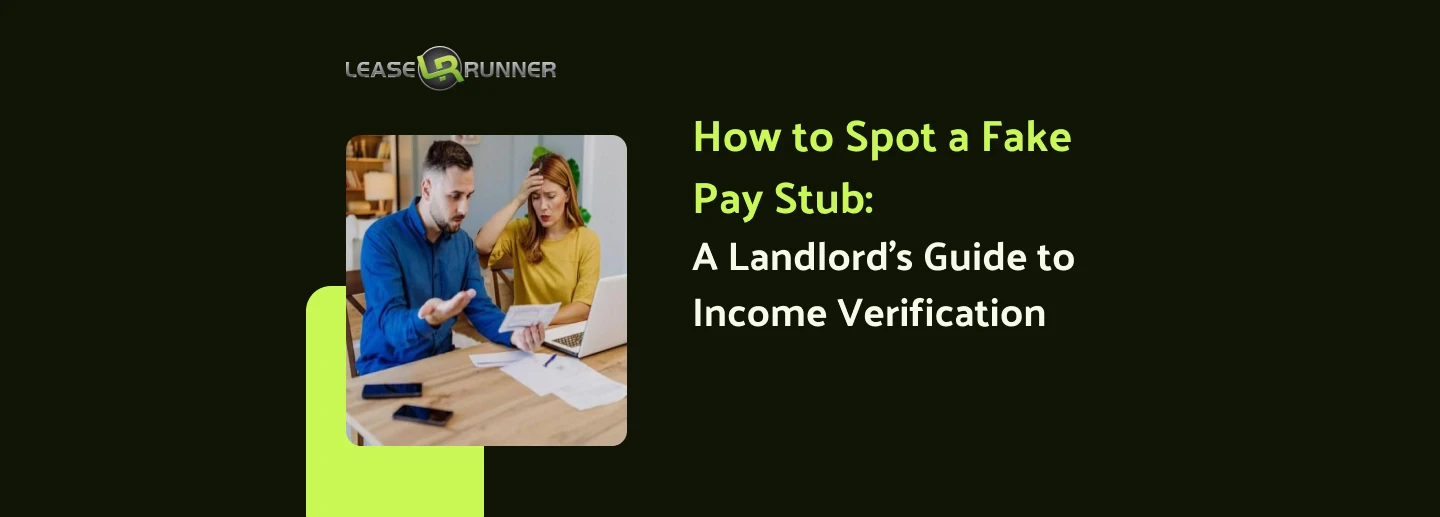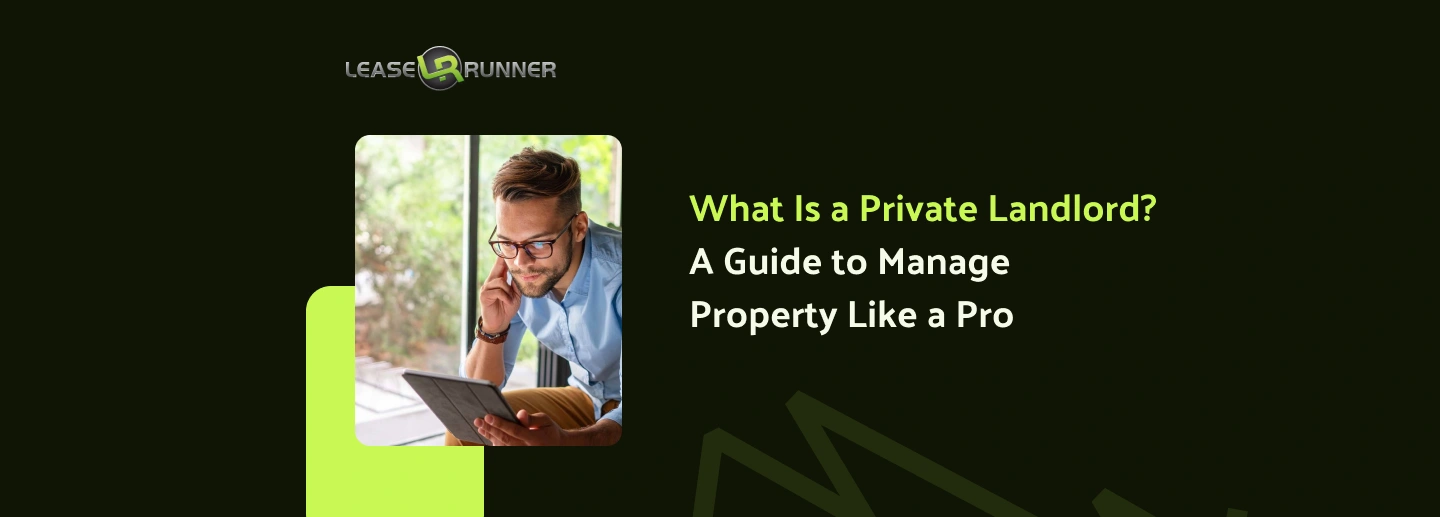In the rental market, knowing how to spot a fake pay stub is essential. Fraudsters are taking advantage of easy-to-use digital tools, making it simpler than ever to create counterfeit pay stubs.
This guide is here to help landlords and property managers quickly learn the telltale signs of fraudulent income documents, understand how real pay stubs work, and verify them effectively. Before we dive in, take a quick look at these essential facts that most renters and landlords search for:
What is a Pay Stub?

A pay stub is more than just a paper slip—it’s a detailed breakdown of your earnings for a specific pay period, provided by an employer. It serves as an essential record of income, taxes withheld, and other deductions. It includes:
- Employer and Employee Information: The legal name and address of the company, and the employee's name, address, and often an ID number or partial Social Security Number.
- Pay Period Data: The exact dates marking the beginning and end of the work period for which the payment is made, along with the actual date the payment was issued.
- Earnings and Deductions: A clear statement of gross income (total earnings before anything is taken out, including regular wages, overtime, bonuses), a breakdown of taxes withheld (federal, state, local, FICA), benefits deductions (like health insurance or retirement contributions), and the final net pay (the actual take-home amount after all deductions). It also typically includes year-to-date (YTD) totals for earnings and deductions.
Understanding these basics makes it easier to answer questions like “what do pay stubs look like?” and “how do pay stubs work?” When you know the standard layout, you’re in a better position to learn how to spot a fake pay stub.
How Pay Stubs Work (And What Real Ones Look Like)
Real pay stubs are produced using payroll software systems that are designed to accurately keep track of taxes, deductions, and employee files. Here is generally what one would find on a legitimate pay stub:
- Employer Information: Company name, address, and sometimes, the company logo.
- Employee Information: Employee name, employee ID, and sometimes department.
- Income information: This is the total amount an employee earned before any taxes or other deductions are taken out. It will often itemize different types of earnings, such as regular hours, overtime hours, and pay, bonuses, commissions, or vacation pay.
- Dates: The pay stub typically identifies the pay period and the pay date.
- Deductions: These are amounts subtracted from gross pay. They typically fall into two categories: mandatory and voluntary deductions. About mandatory deductions, these include federal income tax, state income tax (if applicable), and FICA taxes (Social Security and Medicare).
About voluntary deductions, these are amounts the employee opts to have withheld, such as contributions to health insurance premiums, retirement plans (like 401(k)s), Flexible Spending Accounts (FSAs), Health Savings Accounts (HSAs), or union dues.
- Net Pay: This is the "take-home pay" – the amount the employee actually receives after all taxes and deductions have been subtracted from their gross earnings. This figure should match the amount deposited into their bank account.
- Year-to-Date (YTD) Totals: Most pay stubs will show cumulative totals for all earnings (gross and net), and deductions from the beginning of the year up to the current pay period. This provides a running summary of financial activity for the year.
When you view a pay stub that has all predictable layouts and calculations consistent with a real pay stub, you probably are not looking at a fake one. Nevertheless, continue to be aware of the red flags that you would look for to learn how to identify a fake pay stub.
Can Apartments Legally Verify Pay Stubs?
The answer is yes. This question is one of the most frequent inquiries for property managers is whether apartments can actually verify pay stubs. Landlords and property managers can verify a tenant's income, provided they do so legally and with the tenant's consent.
This will not only validate that you are accepting valid documentation, but it also protects you from a legal standpoint. When in doubt about what you can and can’t do, consult trusted resources, such as LeaseRunner's state-specific laws library for better legal understanding.

How to Verify a Pay Stub Properly? A Step-by-Step Guide
Wondering how many steps apartment' owners verify pay stubs or ensure you aren’t given fake pay stubs for apartment applications? Here’s a clear, ordered 7-step process for landlords to protect themselves and their property.
With these steps, you can significantly reduce the risk of accepting fraudulent applications and ensure a tenant's claimed income is genuine, as fake pay stubs often feature inconsistencies like rounded numbers, mismatched fonts, missing tax details, or unprofessional layouts.
Step 1: Reviewing Recent Pay Stubs
The first step in knowing how pay stubs are verified is to study the document itself. Compare your applicant’s pay stub side-by-side with a real, authentic check from a known employer (or look at other examples you trust). Details like font type, company logo clarity, and layout should match.
Mistakes in formatting, fuzzy images, or inconsistent pay period wording are often seen on fake pay stubs for an apartment. Unexplained errors are strong signs to investigate further.
Step 2: Cross-Checking with Employment Verification
If you ever wonder how to get verification of income, the best first move is to contact the employer's HR department by phone or email. Ask the HR department to confirm employment status, salary, hire date, and pay frequency.
Many property managers see the phrase, "Do landlords verify paystubs?" and the answer is yes. When verifying paystubs, the landlord cares most about one thing: a tenant's consistent and sufficient ability to pay rent.
The HR department can contact the employee, and this is the best and most reliable way to find out how to uncover a fake proof of income before allowing someone to sign the lease.
Step 3: Analyzing Tax and Deduction Details
Looking for clues in deduction lines answers the question: What do apartments look at on pay stubs? An authentic proof of income pay stub lists federal and state taxes, Social Security, Medicare, and sometimes insurance or retirement.
Strange or missing deductions suggest editing or forgery. Being skeptical of odd numbers is a key part of how our pay stubs are verified by most leasing offices.
Step 4: Comparing Historical Pay Stubs
Landlords need to see patterns, not just one good-looking document. Always require at least two or three months for apartment rental. Compare gross pay, net pay, and deduction trends.
Sudden jumps, missing weeks, or ever-changing company details could show the stubs came from a fake pay stub website rather than payroll.
Step 5: Utilize Third-Party Verification Services
Today, many offices use tenant screeners. These sites read verifiable check stubs and cross-check the pay info with outside sources like payroll databases or the IRS. It’s the fastest way to spot fake pay stubs for apartment applicants, and it speeds up the answer to how apartments verify income.
Step 6: Checking Bank Statements
Another strong method for stopping fake proof of income is to ask for the renter’s last three months of bank statements. Match the employer’s name, deposit dates, and amounts to those on each proof of income pay stub.
If a direct deposit does not appear or the details are off, you may be dealing with fake pay stubs for an apartment. Apartments rely on this bank match as real-world proof.
Step 7: Requesting Additional Documentation
If doubts remain, get more information. Ask for W-2s, tax returns, or a direct verification letter from the employer. Persistent applicants supplying only pay stubs and fighting extra checks can be hiding something. These extra steps ensure each claim is backed up and that your verifiable check stubs are truly credible.
By working through each of these seven steps, you fully answer not just how do apartments verify pay stubs, but also how do apartments verify your income, and what actions to take if you suspect counterfeit documents. This keeps your process strong, your tenants honest, and your property business secure.
10 Red Flags That Could Mean a Pay Stub Is Fake
Here are ten warning signs that you might be looking at a counterfeit pay stub:
1. Perfect formatting or overly clean design
Real pay stubs, while neat, often contain small imperfections. If the document is excessively perfect, it might be a sign that it was generated digitally. Authentic stubs sometimes include slight variations due to printing or software quirks.
2. Rounded numbers (e.g., $1,000.00 exactly)
One of the simplest giveaways is seeing perfectly rounded figures. Real payroll calculations often include fractions of cents. So, if you see too many numbers ending in .00, it’s a red flag on how to spot a fake pay stub.
3. Inconsistent Fonts and Layouts
A genuine pay stub will have a consistent font and layout. If you notice that the fonts change or the layout looks mismatched, it might be pieced together from various templates. Ask yourself, “how are pay stubs verified?”, consistent formatting is key.
4. Missing Tax or Deduction Details
Every real pay stub lists federal and state tax deductions, Social Security, Medicare, and other withholdings. If these details are missing or incomplete, the document might be fraudulent.
5. Incorrect or Outdated Employer Information

Check that the employer’s name, address, and logo are current and correctly presented. Any misspellings or outdated details can indicate that the document isn’t genuine.
6. Poor-Quality Graphics or Logos
Logos and other graphics should be clear and high-resolution. Low-quality images might be a sign that the document was produced using a free online tool—another hint on how to spot a fake pay stub.
7. Unusual Pay Period Dates
Look closely at the dates on the stub. Overlapping pay periods or dates that don’t make sense can be a sign of a fake. Authentic pay stubs always follow a logical timeline.
8. Lack of Unique Document Identifiers
Real pay stubs often have a reference number, barcode, or digital signature that makes each document unique. The absence of these markers is suspicious.
9. Discrepancies in Gross vs. Net Pay
Mathematical errors or inconsistencies between gross pay, deductions, and net pay are a strong indicator that the document is not genuine. If the math doesn’t add up, you’re likely looking at a fake.
10. Overly Generic or Template-Based Content
If the document appears too generic—like a one-size-fits-all template- it might be a counterfeit. Authentic pay stubs include specific details unique to the employer’s payroll system.
How to Report Fake Pay Stubs?
Finding fake pay stubs for an apartment application is a serious matter. Landlords and property managers play a key role in stopping fake proof of income scams. Taking fast, proper action will protect your property and the rental industry from fraud.
Report to Authorities
If you discover fake pay stubs for an apartment during screening, start by contacting local law enforcement. In some cities, filing a police report for fraud is encouraged, especially if identity theft or fake documents are involved. Inform local landlord associations, too—sharing information may stop repeat offenders.
Gather Evidence
Keep copies of all paperwork, including the suspicious verifiable check stubs and all communication with the applicant. If you spotted unusual fonts, mismatched numbers, or deposit mismatches, highlight these as red flags.
Collecting emails, bank statements, and even texts provides a solid case. This documentation will be needed if you pursue civil or criminal action.
Consider Legal Counsel
Property managers dealing with persistent or professional fake proof of income schemes should seek legal advice.
An attorney can advise you if you should simply reject the applicant, pursue damages for wasted time, or contact police for fraud charges. Legal guidance helps if the applicant disputes your rejection or threatens legal action.
Tools That Help Detect Fake Income Documents

Some applicants use fake pay stubs not just for affordability but also to mask unstable or short-term employment histories. To counter the rise in fake pay stubs, a variety of tools and services are available.
These can be grouped into two main categories: AI-powered document analysis tools and third-party tenant screening services. Both help landlords spot fraud and make safer rental decisions.
AI-Powered Document Analysis Tools
These tools utilize artificial intelligence to analyze a pay stub document for signs of fraud. Rather than reading the numbers, they are actually searching for small mistakes that humans can’t detect.
They will analyze each font and check for font sizes, misaligned text, and double-blurred logos, which are all signs of a fake document. They can even detect if the numbers are all nicely rounded. Most pay stubs are not in tidy even-dollar amounts, like $3,000.00, for example.
These scanners also evaluate the document's metadata, which contains the hidden information about how that file was generated. Metadata can show if a document was created in a pay stub generator online or had been manipulated after it was created.
For example, companies like:
- Resistant AI
- Inscribe
- LeaseLock + Aptly
- Ocrolus
- Snappt (often integrated with platforms like ResMan or Yardi Breeze)
These tools or services can scan a pay stub in seconds and will even show flagged areas that look suspicious. This is a safe way to detect forgeries quickly and accurately without being an expert in the area!
Third-Party Tenant Screening Services
Third-Party Screening Programs The latest tenant screening platforms now include a built-in income verification that can allow screeners to skip pay stubs altogether. Third-party screening can get payroll data straight from the applicant's bank account deposits, providing a more reliable picture of their finances.
A great example is the Income Verification and Cash Flow report by LeaseRunner. This feature gives landlords a real-time, verified view of an applicant's income and financial trends by securely connecting to their bank accounts.
LeaseRunner’s service offers insights into cash inflows, spending habits, and account balances, helping landlords assess a tenant's true ability to afford rent. This method is often more straightforward and reliable than trying to recognize a fake pay stub on your own, providing peace of mind and reducing the risk of rental payment issues.
Final Thoughts
Learning how to spot a fake pay stub is a crucial skill for every landlord and property manager. By understanding what genuine pay stubs look like, recognizing red flags, and using a mix of manual and automated verification tools, you can protect your investments and ensure a smooth tenant screening process.
Keep these points in mind as you evaluate income documents: always compare with known genuine pay stubs, contact employers directly when in doubt, and use reliable third-party services to cross-check data. More importantly, visit the LeaseRunner blog for more detailed information.
FAQs
Q1. Can You Fake a Pay Stub?
Modern digital tools make it quite easy for someone to generate a fake pay stub. However, these fake documents may appear authentic at first glance, but they usually miss important details that real payroll systems include.
Q2. How to Make Fake Check Stubs?
Creating or using fake check stubs is illegal and unethical. Rather than trying to make fake documents, always use proper verification methods to confirm income.
Q3. How to Spot a Fake ADP Pay Stub?
- Examine the Design Closely: Compare it to official ADP pay stubs by checking logos, fonts, and overall formatting.
- Red Flags: Watch for too-perfect formatting, perfectly rounded numbers (like exactly $1,000.00), or missing tax details.
- Contact ADP: When in doubt, reach out directly to ADP or the employer for confirmation.
Q4. Do Apartments Verify Pay Stubs?
Yes, they do. Many landlords and property managers require verification of income documents as part of their tenant screening process.
Q5. Are Payslips and Pay Stubs the Same?
Yes, both terms refer to documents that show an employee’s earnings and deductions.







